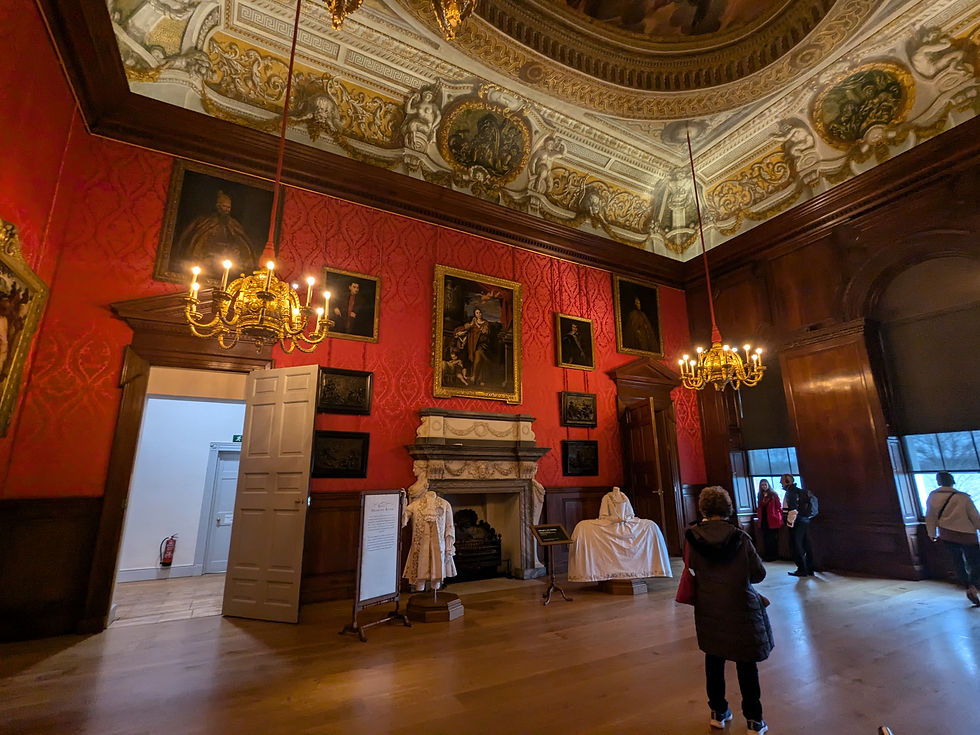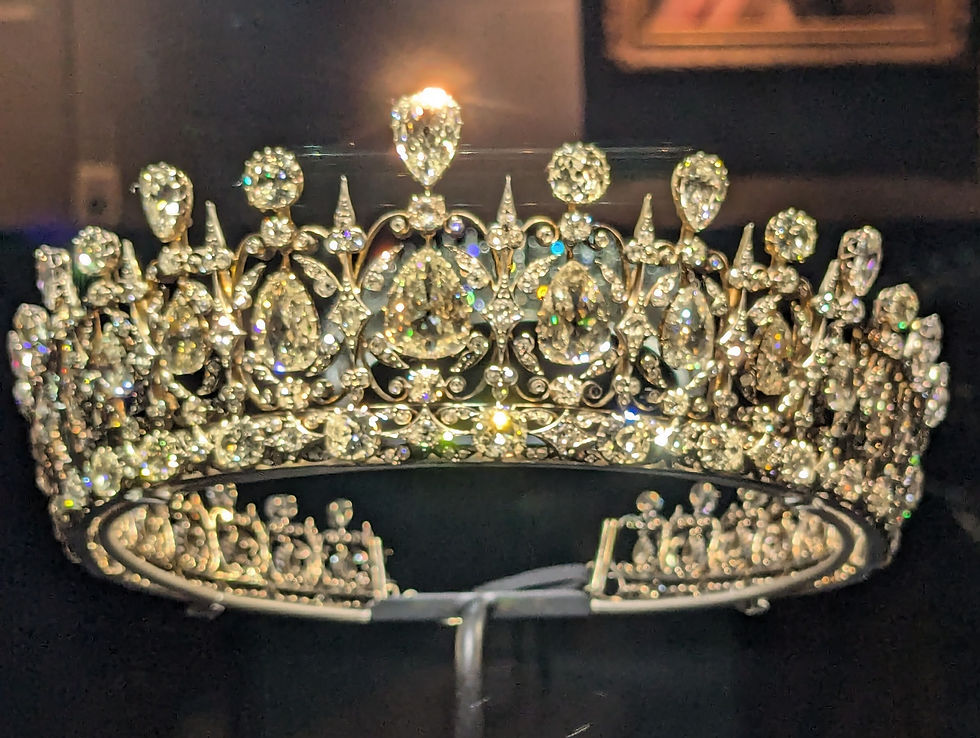Dorking and Kensington
- chirp54
- Dec 23, 2024
- 7 min read
Last year when we were staying in Ashtead, I took the train to Dorking and discovered the Dorking antiques district. Since it's less than an hour from London I decided to take the day to revisit it. It was a nice journey there and I had a wonderful time perusing all the shelves of all the stores. My favorite item was this novelty oil can. Do read the tag.

It's such fun to rummage around in stores where 1940 is merely the recent past. So much of what you see in the cases goes back a hundred years or more. Such fun. Wish I'd bought that oil can.
At the end of the day I went to the Dorking Station to catch my train only to find it was going to be late. They weren't sure how late. After waiting about 45 minutes I walked to the nearby Dorking Deepdene train station. A train was due in 10 minutes or so, but would take me pretty far out of the way and would have added 45 minutes to my journey, so I walked back to Dorking. About 10 minutes later a train arrived and I hopped on. Great, that was easy. Oh, wait - no, it wasn't. The train was rerouted. To make a long story short, the return trip took just under three hours from scheduled departure to arrival at the flat. Oh, well.
The next day, I decided to visit Kensington Palace. KP is enormous and includes the residence of the current Prince and Princess of Wales, William and Kate. One part of the palace is open to the public. Outside the entrance is a statue of Queen Victoria, who was born at Kensington Palace. The Palace sits in the middle of Hyde Park.

Tis the season, so there's a Christmas tree decorated in pink. I was there during the day but wondered if, at night, it was covered in pink lights. Lovely wreath by the door, too.


Again, in honor of the season, there was a special little set piece which was meant to represent Queen Victoria's box at the ballet. Visitors could sit in the royal box and have their friends photograph them. I thought about asking a passer-by to take my picture but with my luck, they'd walk away with my phone.

There are free audio guides to borrow, which are really helpful and quite informative. Once into the Palace, you can choose from three tours: The King's State Apartments, The Queen's State Apartments, and Victoria: A Royal Childhood. I started with the King's Apartments. The King, in this case, is George II. (Kensington has been used by a number of monarchs, so the powers that be can choose which era to represent.) You start by climbing the stairs, the stairwell of which is decorated with tromp l'oeil architectural features.

You can point your audio guide toward some of the illustrations and listen to stories about the person depicted. Very clever.
Once up the stairs, you enter the Presence Chamber, a sparsely furnished red room with a ceiling inspired by the decorations found in Roman houses that had been recently excavated on the Palatine Hill in Rome.

The only piece of furniture in the room is the King's Throne. Guests would be ushered into the room to bow and kiss the king's hand.


The next room is the Privy Chamber, which was one of Queen Charlotte's favorite entertaining spaces.


I loved the plaster of Paris casts of the clothes that would have been worn during the period.
The next room is the Cupola Room with its magnificent clock, known as the Temple of the Four Grand Monarchies of the World.

The clock was also a music box and on each side are portraits of monarchies from antiquity.
This room was the first commission of William Kent, the artist and designer who would go on to decorate the rest of the State Apartments.
King George and Queen Caroline were patrons of the composer George Frideric Handel who often brought his troupe of Italian opera singers to the palace to perform.
The grandest of the rooms is the King's Drawing Room.

On the ceiling, William Kent had shown the powerful god Jupiter, who accidentally killed his lover, Semele. The message seems to be, "Watch out!"

At the king's parties this room would be filled with courtiers in search of power and patronage. The king's bedchamber was next door and halfway through the evening he would come out to make his appearance. Guests would arrange themselves in a circle, hoping to speak to him. If you were lucky, one of the high court officers would introduce you to the king.
The last room in the King's apartments was the King's Gallery where he and Queen Charlotte would take their exercise (walk up and down the room.)


One feature of the room is the wind dial over the fireplace which allowed the king to see if the winds were fair for an invading fleet to come up the English Channel.

I then visited the Jewel Room. I have vague memories of the jewels of the Tower of London but these were spectacular in their own right and you could get a lot closer to them. Princess Louise's tiara/necklace:


Queen Victoria's emeralds:





These jewels are magnificent, but there's still this little voice in the back of my head that keeps telling me to remember the condition under which most Victorians (and Edwardians, and most dynasties for that matter) lived and how this sort of wealth is obscene. Hmm, kind of sounds like Musk, Bezos and the like.
I'd been keeping my eye on the clock because there was a talk I wanted to attend about Queen Victoria's childhood at Kensington Palace. I rushed upstairs and was passed through the velvet ropes to the last room on the tour of the Victoria's Royal Childhood where the talk was due to take place. A wonderful, well-spoken woman talked about Victoria, her upbringing, her marriage, and Kensington Palace's place after her marriage to Prince Albert. Victoria was never meant to be queen, but a series of deaths put her into the line of succession. Victoria's father died shortly after her birth and she became heir to the throne because the three uncles who preceded her in the line of succession – George IV, Frederick, Duke of York, and William IV – had no surviving legitimate children.
Victoria spent her first few months surrounded by love and luxury but all that changed upon the death of her father when she was just eight months old. His insurmountable debts made life difficult for Victoria’s mother. Although desperate and impoverished, she was allowed some rooms in Kensington Palace. Here she grew close to John Conroy, a man who had been equerry to her late husband. He soon inveigled his way into her life, becoming a trusted confidant. The pair then conspired to control the young Victoria, believing with absolute certainty that one day she would be Queen and they wished to be the power behind the throne. As Victoria grew older, life in Kensington Palace became increasingly lonely and oppressive. Her only enjoyments were time spent with her little dog, Dash, and her beloved governess, Baroness Lehzen.

The strict regime that her mother and Conroy enforced, which they called the ‘Kensington System’, was invented to keep Victoria within their control. It was a very unhappy childhood.

Victoria ascended to the throne at age 18. From the moment she heard the news that her uncle, King William, had died, she asserted her authority and broke free of her mother and Conroy. Upon becoming queen, Victoria moved to Buckingham Palace. Kensington Palace was subsequently used as a residence by several of her nine children.
When the talk was over I went back to the start of the Victoria tour and was quite surprised to see the relative simplicity of the rooms, especially when compared with the King's State Apartments.


The room in which Victoria was born:

From there it was on to the Queen's State Apartments. In this case the queen is Queen Mary, as in William and Mary. In 1688 William, the Protestant ruler of the Netherlands and his wife Mary, were invited by the English Parliament to take the throne in place of Mary's father, Catholic King James II. William arrived by sea in Devon and was welcomed into the country. James, his wife, and baby son fled to France in what became known as the Glorious Revolution. (British history is so complicated and convoluted!)
The Queen's apartments are deliberately plainer than the king's. The wooden staircase matches the taste of Queen Mary for whom they were built by Christopher Wren.

The Kensington Palace guidebook says that Mary's marriage to William started badly; she cried for days after hearing that this match had been made. William was twice her age, was a chromic asthmatic, lived in another country and spoke another language. But ultimately they became a loving couple. It was in the Netherlands that Mary developed her passion for collecting treasures from India, China and Japan. There are several of these pieces in the Queen's Gallery.



She filled the room with embroidered silk hangings, Persia rugs and as many as 150 pieces of Chinese and Japanese porcelains.
The Queen's Dining Room:

William and Mary were very modest in their tastes and preferred dining alone in this simple room.
The Queen's Bedroom:

In 1694 Mary discovered a rash on her arm; it was smallpox. William was distraught and slept on a camp bed in her room to be near to her. She died here at Kensington Palace, aged thirty two.
I went back to the King's Apartments to hear another talk, this one on health sanitation, and diseases in Kensington Palace. Sadly, this talk was given by a different guide, an American, who was neither well-spoken nor well-informed. Had I not been sitting in the front row I would have walked out. Oh, well.
I always seem to find delight in the quirky things, like this sign on the ladies room door.

As I left Kensington Palace grounds I passed the Gates of the Palace which are quite lovely.

I walked around Hyde Park then up the street next to the park with its many mansions and where some embassies are headquartered. Several were done up nicely for Christmas.

Then it was back to Kensington High Street to get the tube home. The entry is in a modern arcade - not quite as charming as the Victorian ones, but pretty nonetheless.

There's quite an interesting topiary - I wonder if that's in lieu of a Christmas tree.




Comments